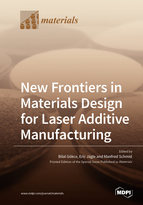New Frontiers in Materials Design for Laser Additive Manufacturing
A special issue of Materials (ISSN 1996-1944). This special issue belongs to the section "Manufacturing Processes and Systems".
Deadline for manuscript submissions: closed (31 August 2022) | Viewed by 18204
Special Issue Editors
Interests: laser material processing; nanoparticles; metal and polymer powders for additive manufacturing; composites; nonlinear optics
Interests: alloy design; additive manufacturing; L-PBF; compositionally complex alloys
Special Issues, Collections and Topics in MDPI journals
Interests: additive manufacturing; laser sintering of polymers
Special Issues, Collections and Topics in MDPI journals
Special Issue Information
Dear Colleagues,
In recent years, the industry has started to use parts printed by powder-based laser additive manufacturing (LAM) when precision and good mechanical properties are required. Applications can be found in the aerospace, automotive, and medical sectors. However, the powder materials available are often inadequate for today’s processing tasks. They lead to process instabilities as well as porosities and defects in the resulting parts.
This Special Issue, “New Frontiers in Materials Design for Laser Additive Manufacturing”, will be focusing on advances in material design and development for laser additive manufacturing. Of particular interest are original papers dealing with metal and polymer powders for Laser Powder Bed Fusion or Directed Energy Deposition. In this Special Issue, we are especially interested in answering the following questions:
How can laser process parameters and materials properties be adapted to the LAM process via matrix modification (e.g., alloying, doping, compounding) of powders?
How can powder properties like flowability, wetting, porosity, or (heterogeneous) nucleation be adapted to the LAM process via surface modification of powders?
How may calorimetry, high-speed videography, pyrometry, and online spectroscopy, as well as modeling, contribute to understanding melting and recrystallization dynamics and the lateral distribution of the thermal process window?
It is our pleasure to invite you to submit a manuscript to this Special Issue.
Prof. Dr. Bilal Gökce
Prof. Dr. Eric Jägle
Dr. Manfred Schmid
Guest Editors
Manuscript Submission Information
Manuscripts should be submitted online at www.mdpi.com by registering and logging in to this website. Once you are registered, click here to go to the submission form. Manuscripts can be submitted until the deadline. All submissions that pass pre-check are peer-reviewed. Accepted papers will be published continuously in the journal (as soon as accepted) and will be listed together on the special issue website. Research articles, review articles as well as short communications are invited. For planned papers, a title and short abstract (about 100 words) can be sent to the Editorial Office for announcement on this website.
Submitted manuscripts should not have been published previously, nor be under consideration for publication elsewhere (except conference proceedings papers). All manuscripts are thoroughly refereed through a single-blind peer-review process. A guide for authors and other relevant information for submission of manuscripts is available on the Instructions for Authors page. Materials is an international peer-reviewed open access semimonthly journal published by MDPI.
Please visit the Instructions for Authors page before submitting a manuscript. The Article Processing Charge (APC) for publication in this open access journal is 2600 CHF (Swiss Francs). Submitted papers should be well formatted and use good English. Authors may use MDPI's English editing service prior to publication or during author revisions.
Keywords
- Powder-based additive manufacturing
- Laser powder bed fusion
- Directed energy deposition
- Metal powders
- Polymer powders
- Nanoparticles
- Selective laser melting
- Laser metal deposition









